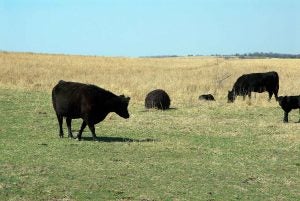A few simple management strategies can reap the benefits of ideal pasture nutrition this spring grazing season
As spring approaches and temperatures start to rise, so do winter forages. Cool season grasses are a nutrient-rich feed, that when grazed properly can be a valuable asset to a production system. In some areas, limited rainfall over the fall and winter months has added some challenges for wheat pasture growth.
However, “as commodity prices continue to increase, wheat pasture is a great resource to offset feed costs while promoting good average daily gains,” says Katie Raver, Rock River Laboratory animal nutrition and field support specialist. “Understanding the rapidly changing nature of these pastures can help us better manage them for maximum cattle potential.”
Raver shares three tips to make the most of spring grazing a beef herd — taking advantage of the forage available for optimal animal growth.
Timing for ideal nutrients and energy
As with all crops, as forages mature, fiber levels typically increase while protein levels decrease. This can have a large impact on available nutrients and energy for growth.
“Available nutrients and energy for growth can be estimated using calculations such as total digestible nutrients (TDN) or beef per ton estimates,” explains Raver “A nutrient value decrease can happen quite quickly as the forage matures and goes from a vegetative state to a reproductive state.”
Raver concludes that maturing forages can lead to a sizable decrease in the estimated amount of predicted beef gain per ton. Understanding these changes can help better decide how and when to utilize the forage.

Keep an eye on stocking density
Forage availability plays an important role in grazing management and, when combined with quality, can provide a better understanding of the gain potential.
“Stocking density must be balanced between average daily gain per head and gain per acre to maximize the grazing and economic potential,” recommends Raver. She goes on to explain that when looking at spring cool season grasses, one rule of thumb is that for every inch of grazable plant height there are about 200 pounds of forage dry matter (DM) per acre, this can then be used to help determine stocking density based on desired rate of gain.
As quality of the forage changes, it also has an impact on animal growth and intake potential. “Plants maturing and becoming more fibrous may also limit intake potential,” says Raver. – “This typically coincides with a decrease in TDN, which may limit average daily gain (ADG) potential when combined with lacking intake potential.”
Analyze to make informed decisions
Testing forages in standing fields or pasture can help assess pasture quality and help to make decisions on cattle and pasture management. “This can prove difficult due to the heterogeneous nature of the stand, however following an established protocol can help to ensure a representative subsample,” says Raver. “To sample a standing pasture or field, take a one-square-foot subsample for every ten acres of the field or pasture.” Raver gives the example, “if you have a 50-acre field you’ll want to gather five subsamples.”
In each one by one foot section, Ravers suggests clipping the forage at the base of the stem that represents the portion of the plant that will be likely grazed by the animal. “Once the forage is cut, chop it into small sections and put into a bucket, then repeat this step for each one-by-one section,” states Raver. “Mix the sample together, then take a one-quart representative subsample to send to the lab for analysis.”
Testing can not only help determine the quality and maturity of the available pasture forage, but it can also help owners and nutritionists better determine a supplementation program to best fit the pasture program and maximize the growth of the cattle.
Spring grazing is just around the corner, but it’s not too late to implement the strategies mentioned here to provide the herd optimal energy and nutrition with pasture forages. “Knowing what prices look like in the coming year, it’s a great time to reap all that is available from the pasture,” suggests Raver. With these simple management steps, nutrition, growth, and even some savings can be achieved in many operations.


